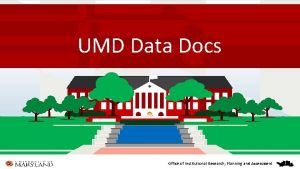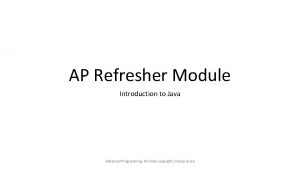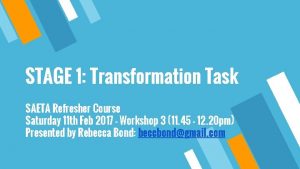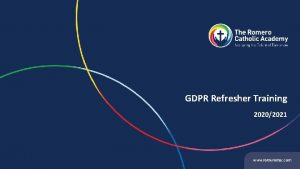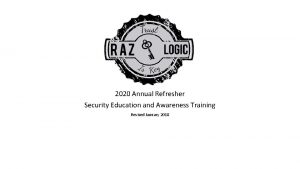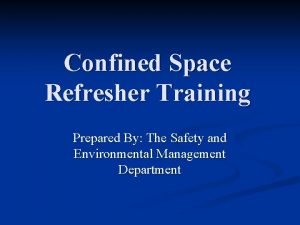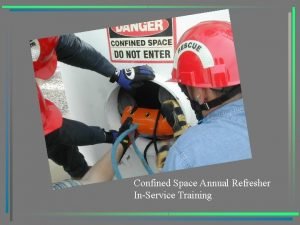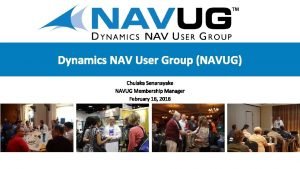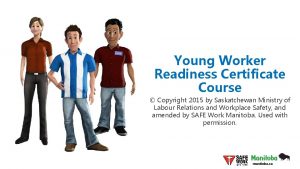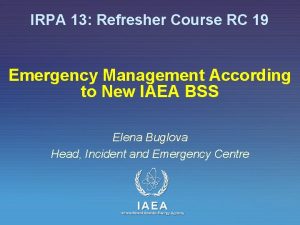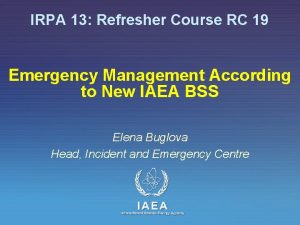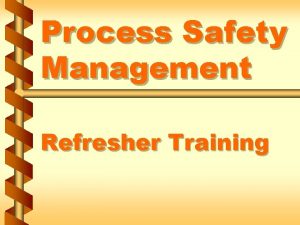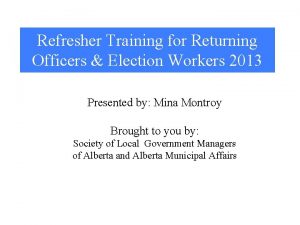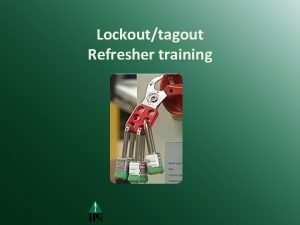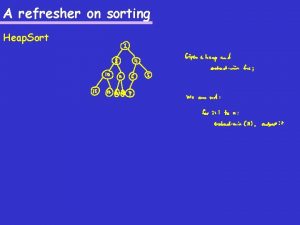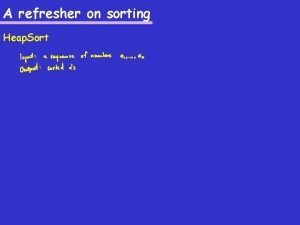IRPA 13 Refresher Course 8 Training Workers in


















- Slides: 18

IRPA 13 – Refresher Course 8: Training Workers in RP for a Safer Work Environment Virva Nilsson Forsmark NPP Department for Safety and Environment - Radiological Safety 2012. 05. 15 Open (S 1) © Forsmarks Kraftgrupp AB

The Purpose of Training? Did I tell you I´ve been teaching Figo how to whistle!? No, of course not. I only said I´ve been teaching him! © Forsmarks Kraftgrupp AB No you didn´t. Are you really saying that Figo can whistle?

Contents ü Why training of Workers in RP? ü A Brief Selection from the Framework ü How to Help People Learn? Ø The Guiding Principle Ø How Do People Learn? Ø The Three Dimensions of the Participant´s Personality Ø The Three Phases of Training Ø The Three Steps of the Learning Helix Ø Planning for Competence Ø Application of 3 D in Your Training Course ü Miscellaneous Thoughts Regarding E&T and Conclusions © Forsmarks Kraftgrupp AB

How About You? How many of you present today are trainers yourself? Could you, trainers, please raise your hand? © Forsmarks Kraftgrupp AB

Why Training of Workers in Radiation Protection? How well Radiation Protection (RP) at a nuclear power plant works is never just a question about RP personnel. It is also always a question about how well the workers behave regarding RP. It is then just common sense to train them prior entering a radiologically controlled area, right? But… There is, of course, a legal framwork of different directives, legislation e. g. we all are obliged to follow. In this framework of documents demands are made on that we train the personnel and even on how we are to do it. © Forsmarks Kraftgrupp AB

A Brief Selection from the Framework Legislation and Directives on the national level which all licencees must obey, are set by the national regulator/government. These documents do not often really demand the level of commitment according to industry good or best practice. IAEA Safety Standards Series – status derived from the IAEA´s Statute. The Safety Fundamentals – The Safety Requirements – The Safety Guides. The Series define the principles of protection and the requirements that we must meet, as well as offer guidance on how we can comply with these requirements. Different Guidelines, Guidelines WANO e. g. – the industry good and/or best practice © Forsmarks Kraftgrupp AB

How to Help People Learn – The Guiding Principle The key question with all training is: What, exactly, shall the participants be able to do after they´ve completed the training? Objectives (aims, goals and targets) must be formulated as measurable and observable – otherwise it is impossible to see if they are reached or not. When planning for and designing training courses the right question to ask is: What shall the participants be able to do after the training? = the desired outcome It is a common mistake to concentrate on ”what to tell about the subject”. Another common mistake is to not formulate the objectives in a way that make them observable, for example: ”the participants are informed about…”, ”understand…”, ”realize…” – in these cases – what is the objective and how can it be measured whether or not it is achieved? © Forsmarks Kraftgrupp AB

How Do People Learn? According to a very old story… There were three men working as stone masons at a construction site chiseling stone. They were obviously doing exactly the same work, but when asked… they gave three totally different answers. physically demanding, hard work, the tools Z one has to be careful when measuring, all the details have to be exactly right X I am building a cathedral! Y © Forsmarks Kraftgrupp AB

How Do People Learn? These stone masons with completely different conceptions of the same job correspond to the three dimensions of our own personalities Having real competence means that each one of the dimensions has gained the correct qualifications in the correct manner. Z Z: the skill to perform the task – mental or physical, or both X: the knowledge that is needed – theoretical, formal, X factual Y: the understanding of the task and it´s value – the attitude towards it The 3 D-way of viewing competence is useful for a trainer who really wants the participants to gain the desired competence – and do it well. © Forsmarks Kraftgrupp AB Y

The Three Dimensions of the Participant´s Personality We all are 3 -dimensional personalities. The visual dimension to reach the ”picture” picture brain (Y) ØShow the whole picture, picture the context Let the participants see the purpose and show examples before showing how the result is to be achieved ØUse graphics, graphics diagrams, diagrams write down, down draw pictures The auditory dimension to reach the ”word” word brain (X) ØTell the participants what the goals and aims are, let them describe these in their own words in each part of the training. Put words on all activities ØRemember: there are limitations to the word brain. Start with small doses of information followed by activity The physical dimension to reach the ”activity” activity brain (Z) ØLaughter lubricates learning! learning ØMake the participant physically active, active engage the muscle memory – saying, handling, touching, pointing ØSee to it that the participant acts correctly ØThe participant should be more active than the trainer. © Forsmarks Kraftgrupp AB

Planning for Competence – 3 D Competence viewed in a 3 D-perspective: 3 D-perspective Y: understanding the context, attitude X: knowledge of the facts Z: performance of the skills Activities for each dimension can be: Y: describe an overall picture X: describe in detail, detail enumerate, match Z: demonstrate with growing complexity The training should be planned systematically: systematically 1. What, What exactly, must the participant learn? = the needed competence 2. Who is the participant? = background, current competence 3. How is he/she going to gain the desired compentence? = design effective learning situations © Forsmarks Kraftgrupp AB

The Three Phases of Training Phase 1 – Overview, visual (Y) Phase 2 – The Parts, auditorial (X) Phase 3 – The Whole, physical (Z) X Y Z © Forsmarks Kraftgrupp AB

Planning for Competence – 3 Phases Phase 1 – Overview, visual ”Y” ØCritical for success ØMotivation is a crucial factor 1. Motivation by causes 2. Motivation by clearly defined objective 3. Motivation by future gain Phase 2 – The Parts, auditorial ”X” ØDivide the whole into ”spoonfuls” of information that can be swallowed one by one ØLet him/her practice each ”spoonful” before starting the next one Phase 3 – The Whole, physical ”Z” ØThis is where the participant should reach the objective of the training ØPhase 3 ought to be ~50% of the total time ØRemember, only if the participant in the end demonstrates exactly what was the objective, he/she has reached it © Forsmarks Kraftgrupp AB

The Three Steps of the Learning Helix Effective learning is a cyclic process The participant climbs up the ”spiral stairs of learning” towards a higher level of competence, one loop at the time. Each loop consists of three steps: 1. Information to the participant 2. Activity by the participant 3. Feedback to the participant © Forsmarks Kraftgrupp AB

Planning for Competence – 3 Steps Step 1 – information to the participant ØMakes the participant able to perform a desired activity ØMeant to trigger the activity Step 2 – activity by the participant ØThe best way of learning is to be active ØStep 2 must produce the correct behavior observed by the instructor Step 3 – feedback to the participant ØFinal step of the loop ØApplying the competence of the objective ØFeedback about the result of the activity ØIs the starting point for further learning © Forsmarks Kraftgrupp AB

Application of 3 D in Your Training Course I wonder…? What would be the aim and objective of your training course/element exactly? üY üX üZ When executing the training course/ element what could you do, as trainer, to make the learning process even more effective in all 3 dimensions? (activities, media etc) üY üX üZ Which dimension would you think is particularly important for a training course in RP? Why? © Forsmarks Kraftgrupp AB How would you like to design Phase 1, Overview, for the training course in RP? (Phase 1 is critical for success, motivation!) In which ways could this phase of your training course be divided into the 3 steps of the learning helix? 1. Information to the participant 2. Activity by the participant 3. Feedback to the participant The key factor in designing effective training courses is to define the objective (aim, goal) clearly with the real training needs as a foundation. What would be, in your case, the desired competence, exactly, and how would you measure the result?

Miscellaneous Thoughts & Conclusions When planning for, designing and executing training courses, the most essential asset is the trainer A trainer in his/her role? role Solid and careful planning and design form the basis of training courses that produce the desired competence Train the trainers Networking. Laughter lubricates learning Give positive learning experiences © Forsmarks Kraftgrupp AB

Thank You for Your Attention! Laughter lubricates learning – give positive learning experiences! I´d like to thank Mr Jansson, UBAB, for all his support in making this presentation. I´d also like to thank Mr Bens, WANO, for the permission to quote WANO GL 2004 -01. © Forsmarks Kraftgrupp AB
 Irpa umd
Irpa umd Java refresher course
Java refresher course Ipv refresher course
Ipv refresher course Saeta refresher course 2021
Saeta refresher course 2021 Gdpr refresher training
Gdpr refresher training Information security program refresher training
Information security program refresher training Confined space refresher
Confined space refresher Confined space refresher training
Confined space refresher training Caution radioactive material
Caution radioactive material Refresher training example
Refresher training example Young worker readiness certificate course
Young worker readiness certificate course Basic training for barangay health workers
Basic training for barangay health workers Basic training for barangay health workers
Basic training for barangay health workers Basic training for barangay health workers
Basic training for barangay health workers Altar worker
Altar worker Basic training for barangay health workers
Basic training for barangay health workers Sql refresher
Sql refresher Chemistry molarity
Chemistry molarity Biology refresher
Biology refresher
